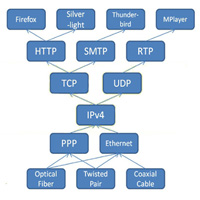Relevant Links
Press Release
Link to Original Paper
Press Contact
Keywords
Internet Architecture, Future Internet, Layering, Network Science, Evolutionary Kernels, Evolution
Buzz
COMPUTING RESEARCH HIGHLIGHT OF THE WEEK [October 14-21, 2011]
How the Internet Architecture Got it's Hourglass Shape
The Internet protocol stack has a layered architecture that resembles an hourglass. The lower and higher layers tend to see frequent innovations, while the protocols at the waist of the hourglass appear to be "ossified". We propose EvoArch, an abstract model for studying protocol stacks and their evolution. EvoArch is based on a few principles about layered network architectures and their evolution in a competitive environment where protocols acquire value based on their higher layer applications and compete with other protocols at the same layer. EvoArch produces an hourglass structure that is similar to the Internet architecture from general initial conditions and in a robust manner. It also suggests a plausible explanation why some protocols, such as TCP or IP, managed to survive much longer than most other protocols at the same layers. Furthermore, it suggests ways to design more competitive new protocols and more evolvable future Internet architectures.
Researchers:
Saamer Akhshabi (College of Computing, Georgia Tech)
Constantine Dovrolis (College of Computing, Georgia Tech)
Institution(s) (that have supported the research):
National Science Foundation, Georgia Institute of Technology
‹ Current Highlight | Past Highlights ›
Computing Research Highlight of the Week is a service of the Computing Community Consortium and the Computing Research Association designed to highlight some of the exciting and important recent research results in the computing fields. Each week a new highlight is chosen by CRA and CCC staff and volunteers from submissions from the computing community. Want your research featured? Submit it!.






